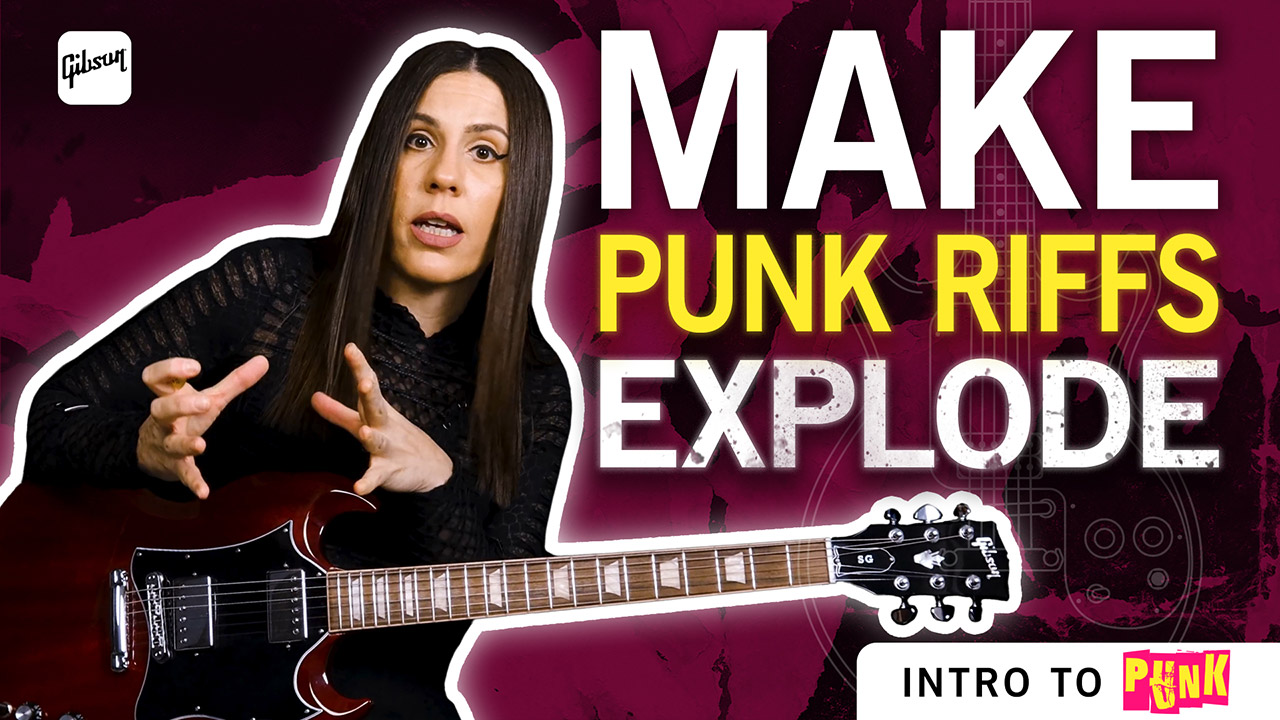Palm muting and steady downstrokes are the key to this technique
Continuing our exploration of punk rock guitar techniques, this beginner-friendly Gibson App video features Irene Ketikidi as she guides you toward mixing up palm muting with ringing powerchords. You’ll hear how to keep your downstrokes super-steady while releasing the palm mute at the end of the riff to get an explosive burst of energy happening.
It’s a staple technique of punk rock. After cycling through the entire sequence to a slow click, Irene says, “You want to hold on to the excitement and urgency this pumping rhythm creates.” The first two installments of this series are here and here.
What are some aspects of punk rock guitar I should consider?
Punk guitarists play with a palpable sense of aggression, embodying the genre’s defiant attitude. This intensity is manifest in fast tempos, often reaching speeds that challenge conventional musical limits, and loud volumes, which amplify the raw energy of their performances. Simple rigs rule the roost, including single-pickup guitars.
The overall rawness is achieved through basic chord structures and a stripped-down musical style that emphasizes energy over technical proficiency, creating a wall of sound that is both unpolished and electrifying. This approach aligns with punk’s DIY ethos, where spontaneity and authenticity take precedence over commercial appeal or production values.
That being said, you’ll find some interesting timbres in punk where delays and echo units are used creatively, surf rock-isms poke through, and basically whatever idiomatic guitar techniques players latched on to in their formative years are used. It all seems to swirl around in a blender.
Where does the punk guitar ethos come from?
There’s an insightful scene in the film, 20th Century Women, where Greta Gerwig’s character, Abbie, acknowledges that punk isn’t about skill, saying, “Yeah, it’s like they’ve got all this feeling, and they don’t have any skill, and they don’t want skill, because it’s really interesting what happens when your passion is bigger than the tools you have to deal with it. It creates this energy that’s raw. Isn’t it great?”
The humble garage, as in many rock styles, has served as the petri dish for tons of seminal punk bands. Many players honed their chops with weekly shows in dingy rooms where crinkled and frayed Xeroxed band flyers lined the walls like chaotic wallpaper as hordes of teenagers flailed about in “the pit,” dancing with abandon just to be part of something that felt more alive than the perceived hell of materialistic suburbia.
Being part of “the scene” became an adolescent rite of passage in the late 70s and early 80s when the Cold War and the threat of nuclear annihilation lurked just underneath every nightly newscast. The soundtrack to that reality may be found in early punk rock.
The aggressive sound of punk is often paired with confrontational and rebellious lyrics, addressing societal issues such as freedom, poverty, inequality, and political corruption, further reinforcing the genre’s commitment to challenging the status quo. You’ll find this on full display within the catalog of originators like Stiff Little Fingers, the Sex Pistols, and even The Clash, who later successfully melded punk-style writing with reggae and other genres. Flying the flag for punk today are bands like Amyl and the Sniffers and Panic Shack.
Explore the world of the Gibson App and start your free trial on iOS and Android devices.

